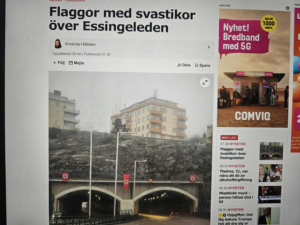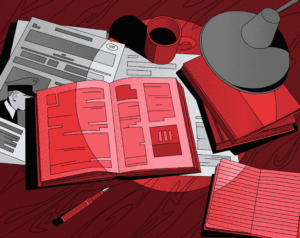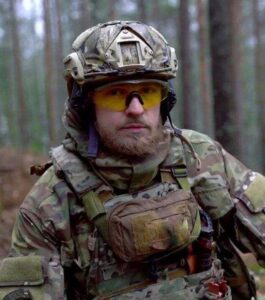By Antifascist-Europe
Nazis in the USSR: Hitler as a game
The first far-right groups, and specifically the neo-Nazis, appeared in the USSR back in the 1950s. Schoolchildren and kids from the families of party officials became involved in neo-Nazi groups, as they were attracted to the aesthetics of Nazism with its parades, the cult of the beautiful body and neoclassical architecture. For this, they were called “stilyagi”. Researchers also distinguish a group of “politicians” – adult far-right dissidents who were attracted specifically to the cult of Adolf Hitler.
The fact that the war against Nazism, in which their fathers and older brothers died, had just recently ended did not bother the Soviet neo-Nazis at all. They believed that the dead were not Hitler’s or Stalin’s fault, but someone else’s – the growing notion that the war was waged in the interests of the United States or “world Jewry”.
The reaction of the authorities to the appearance of neo-Nazis in the USSR was mild. Criminal cases against young neo-Nazis were dropped because investigators concluded that they had gone no further than games. That connivance led to the fact that in the late 1970s the security authorities directly prohibited the Soviet Ministry of Internal Affairs from taking action against existing neo-Nazi groups, and the authorities officially sought to keep quiet neo-Nazi demonstrations in the USSR in every possible way. Researchers suggest that the Nazis were simply used as a bogeyman for the population, and as a pretext for tightening control over youth organisations. Vyacheslav Likhachev, the author of the book Nazism in Russia, writes that in the 1990s the security services turned the best-known neo-Nazi group Russian National Unity (RNU) into a powerful organisation, which acted as a bogeyman at crucial moments, such as October 1993. But when its leader, Alexander Barkashov, tried to get into parliamentary politics, RNU was quickly marginalised.
In the middle of perestroika, the neo-Nazis made themselves known openly. On 20 April 1987, Hitler’s birthday, two columns of young men, ranging in age from 17 to 22, dressed in black shirts and wearing swastikas on their sleeves, marched down Nevsky Prospect in Saint Petersburg and then smashed Jewish graves in cemeteries. At the same time, the persecution of the neo-Nazis ceased “due to the changed political situation”.
The Russian far-right inherited all the characteristics of the Soviet Nazis: young in age, a fascination with Nazi aesthetics and denial of historical facts, antisemitism, and connivance on the part of law enforcement.
The 1990s: the bonehead era
During the 1990s, dozens of nationalist organisations emerged in Russia, as a right-wing reaction to the collapse of the USSR. The most notable phenomenon among far-right radicals in Russia was the neo-Nazi skinheads, or boneheads – an imported British youth subculture from the 1970s which was already in decline in Western countries. Researcher Alexander Tarasov identifies the collapse of the education system, as well as economic decline and unemployment during the market reforms of the 1990s, as the key reasons for the dramatic growth of the bonehead movement in Russia. The war in Chechnya, which intensified hostility towards Caucasians, and the insufficient activity of law enforcement agencies against far-right organisations, also contributed to the growth of bonehead numbers. According to anthropologist Victor Shnirelman, the spread of racism and “Aryan identity” among boneheads in Russia was also affected by anti-communist propaganda and criticism of internationalism during the “wild capitalism” of the 1990s, when social Darwinism and the “pursuit of heroism” promoted the images of a “superman” and a “superior aristocratic race”.
According to researcher Sergei Belikov, the first boneheads appeared in Moscow in the early 1990s. In 1993–1994, there were around 150–200 boneheads in Moscow, and the first groups emerged in other major Russian cities – Saint Petersburg, Rostov, Volgograd and Nizhny Novgorod. In 1998, there were already more than 20 organised associations in Moscow, printed publications, companies that supplied bonehead paraphernalia and music groups.
Also in the 1990s, Russian neopaganism – Russian Vedism or Rodnoverie – became fashionable among the far right, which further caused a division between the traditional black-hundredist Orthodox organisations and the Hitlerists, who denied Christianity as a “Jewish faith” and moved to Wotanism.
After Vladimir Putin came to power in 2000, the far-right movement in Russia reached its peak.
The noughties: the peak of Nazism
In 2001, the ruling United Russia party was formed and its official ideological platform was described as conservatism. The growth of nationalist sentiments in Russia took place against this background.
According to rough estimates, there were about 50,000 boneheads in Russia in the noughties. Dozens of far-right groups grew into large organisations with branches all over Russia and including thousands of boneheads, among them: National Socialist Society (NSO), Slavic Union (SS), Movement Against Illegal Immigration (DPNI), Russian All-National Union (RONS), Russian People’s Movement (ROD), Northern Brotherhood, and Eurasian Youth Union (ESM). All the aforementioned organisations are banned, with the exception of ESM. These were formal organisations engaged in spreading ultra-conservative ideas, opposing migrants and LGBTQ+, and glorifying Slavic identity. Their main goal, as the main bonehead book of the time Skins: Russia Awakens (2003) described, was to create a legal party and get involved in mainstream parliamentary politics.
The main public action for the far right in Russia was the annual “Russian March”, which is held on National Unity Day on 4 November. Vladislav Surkov, the chief ideologist in the presidential administration, came up with the idea of this holiday to replace October Revolution Day, which was politically alien to the Kremlin. National Unity Day was first celebrated in Russia on 4 November 2005 and on this day ESM, an organisation close to the ruling circles, organised the first Russian March.
It should be noted that on the wave of the rise of the far-right, Russian opposition leader Alexei Navalny tried to make a political career as a nationalist. In 2007, he participated in his first Russian March and even spoke from the platform, and created the national Russian liberation movement Narod, which lasted four years.
At the grassroots level, the neo-Nazis during the noughties started a street terror campaign against migrants from the North Caucasus and Central Asia, blacks, Roma, Jews, and gays – all whom they considered “an alien element polluting the blood of the white race”. Boneheads are organised into informal groups to commit hate crimes – murders, arsons, bombings and pogroms. The most famous among them were Mad Crowd and Combat Terrorist Organisation (BTO), Saviour (SPAS), Schultz-88, Lincoln-88, United Brigade-88, NS/WP, Ryno-Skachevsky gang, NSO-North and the Militant Organisation of Russian Nationalists (BORN). In total, members of these groups killed more than 100 people and carried out dozens of terrorist attacks.
In the public field, their mouthpiece was the leader of the Russian boneheads, Maxim “Tesak” Martsinkevich, who promoted racist violence through snuff videos on the “Format 18” project website. Tesak’s involvement in real murders, including the notorious “Execution of a Tajik and a Dag”, would become known only in 2021.
The far-right terror reached its peak by the end of the decade. Whereas in 2005 there were 152 murders committed by Nazis, in 2009 there were 548 cases, the Investigative Committee of the Prosecutor’s Office calculated. Typical of the activity of these groups at the time was BORN, whose members committed a series of high-profile murders, including the murder of Judge Eduard Chuvashov, antifascist movement leaders Fyodor Filatov, Ilya Dzhaparidze and Ivan Khutorskoy, lawyer Stanislav Markelov and journalist Anastasia Baburova.
Many researchers and journalists have noted the connection between BORN and the Kremlin. BORN members Ilya Goryachev and Nikita Tikhonov created ‘’Russian Image’’, an organisation demonstrably loyal to the authorities, and published a magazine of the same name. Goryachev sought to contact officials in the presidential administration to show that Russian Image, unlike the DPNI, is a loyal structure. ‘’Russian Image’s’’ greatest achievement was the concert of popular neo-Nazi bands right outside the Kremlin on 4 November 2009. In addition to political actions, ‘’Russian Image’’ activists actively monitored their political opponents, receiving grants from organisations close to the Kremlin. ‘’Russian Image’’ activists infiltrated police stations and used their deputy assistants status to collect personal data on detained antifascists and passed it to BORN militants. On 16 November 2009 the day after Khutorskoy’s murder, antifascists openly smashed up the reception room of Maxim Mischenko, deputy of the State Duma, who had publicly cooperated with ‘’Russian Image’’.
The power’s alliance with the nationalists ended along with the decade. On 11 December 2010 thousands of nationalists and soccer hooligans rioted on Manezhnaya Square in Moscow after the death of Spartak fan Yegor Sviridov, leaving dozens of people injured. The Manezhnaya Square events became a convenient pretext to tighten control over youth movements and to defeat far-right organisations.
The 2010s: split and decline
At the beginning of the decade, the far-right in Russia found itself in crisis. In 2011 the authorities declared the DPNI, one of the largest nationalist organisations, to be extremist, banning it and jailing its leaders. Other nationalist organisations were banned along the same lines, decimating the far-right political flank. Thereafter, national-radical leaders joined the protest movement in Russia, which began in December 2011. However, they failed to attract new supporters to its ranks and lost militants.
Since 2009, the level of Nazi violence in Russia has been gradually declining, under serious pressure from the police. It is also important to note that many far-right activists have become disillusioned with the effectiveness of street violence. The far right’s need for violence has degenerated into a form of semi-legal raids on places where migrants live. In 2012, bonehead leader Martsinkevich came up with the idea of conducting raids against paedophiles. Pro-Kremlin nationalist youth movements adopted these tactics and began to conduct raids against drug dealers, people drinking alcohol on the streets, drivers who parked badly and stores selling stale food.
The deep crisis of the far-right movement in Russia, the signs of which began to show as early as 2012, was exacerbated by a split over the events in Ukraine. On the one hand, Euromaidan revived the far-right’s hope for the success of the “white revolution” in Russia as well. However, the transition of the Ukrainian crisis from the phase of power–opposition clashes to an armed conflict in eastern Ukraine, which can be interpreted as a confrontation of “Ukrainians against Russians”, presented extreme Russian nationalists with a serious choice. This resulted in former comrades-in-arms finding themselves on both sides of the front and shooting each other in the fields of Donbas.
Many nationalist radicals, together with pro-government nationalists, national Bolsheviks and most national democrats supported the “Russian Spring”, including the annexation of Crimea to Russia and military action against Kyiv in Donbas. But the majority of the far-right, including the top of the Russians movement, turned out to be opponents of the Russian Spring. This position was also based on the denial or downplaying of conflict and the distinction between “Ukrainians and Russians” in general. Accordingly, most of these figures viewed the Ukrainian events as the first stage of a general national revolution against the “anti-Russian regime”, “Jew regime” or “Zionist occupation government” in the Kremlin. In other words, the split occurred along the conditional line of “imperialists” who supported Moscow aggressive actions versus “Hitlerists”, with the latter supporting Kiev, fleeing Russia and joining the “Azov“ regiment, and the other volunteer battalions.
In autumn 2014, Russia launched a powerful police operation against the far right, resulting in its final defeat. Never before in modern Russia have there been so many criminal cases against the leaders of right-wing extremist groups and organisations, most of which have been banned. The rapidly increasing number of convictions for “extremist statements” on the internet has also so far mainly concerned nationalists. Overall, the current decline of the national-radical movement is unprecedented in the entire post-Soviet period, and activists’ awareness of this fact has only exacerbated the decline.
The nationalists’ main action, the Russian March, is also in decline. Whereas in 2011 the largest Russian March was held, with between 10,000 and 25,000 participants, its numbers in Moscow, in particular, fell from about 6,500 participants in 2013 to less than 1,500 in 2016, and the number of cities where it was held fell to 11. It was not held in 2021.
At present, the far-right movement in Russia has noticeably declined in numbers: some of its activists have been arrested, some were killed in combat operations in Ukraine on both sides, some fled to Ukraine, but there are many more who have become disillusioned and moved away from the movement. Those who remained supported the opposition and joined depoliticised raids, such as anti-alcohol raids for healthy lifestyles.
In 2020 Russian nationalist Konstantin Krylov passed away. In 2020 Martsinkevich committed suicide in prison, and in 2021 Yegor “Pogrom” Prosvirnin, the nationalists’ chief propagandist, died after jumping naked from a window in the centre of Moscow.
The far-right moved to libertarianism. In particular, Martsinkevich, before his death, declared Nazism to be a fallacy and expressed his sympathy for the free market. The rabid Nazi militants have gone deep underground and moved into open misanthropy, which in the milieu is called “people hate” (Maniacs. Murder. Cult). The far-right now engage in combat training, and their main propaganda resources have shifted to Telegram due to deplatforming tactics. The most prominent among them is Male State, an openly misogynistic far-right community that cyber-bullies feminists and LGBTQ+ supporters.
Today, due to the exodus of the far-right, ultra-conservative, Orthodox and monarchist organisations close to power, like businessman Konstantin Malofeev’s Tsargrad, have become the most visible element on the right political wing, opposing LGBTQ+ and feminism, stirring up anti-migrant hysteria and spreading conspiracy theories about the Covid-19 pandemic.
The far-right does not act openly for fear of repression, but if there is political turbulence in Russia and the grip of Putin’s regime loosens, the far-right will immediately take to the streets and try to catch up. In this case, they will actively engage in politics at all levels and oppose United Russia and Putin, claiming to be the main opposition force, following the example of Ukraine, and using the violence to strengthen their agenda.
The ruling party United Russia publicly maintains an anti-Nazi rhetoric, which it uses against Ukraine and Western countries. At the same time, United Russia has established contacts with far-right European parties. In December 2016, it signed a cooperation agreement with Austria’s far-right Freedom Party and established contacts with the NATO- and EU-critical Alternative for Germany (AfD) party, which proved an organic ally for Moscow. The youth organisation Young Guard of United Russia became a partner of the AfD’s youth union Young Alternative for Germany. In 2014, United Russia became friends with the French National Front, whose leader Marine Le Pen even wrote a public letter to the leaders of the Russian party. Then it became known that Le Pen received a loan for her election campaign in France from a Russian bank.







